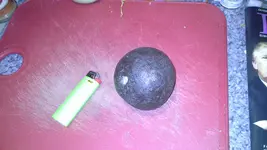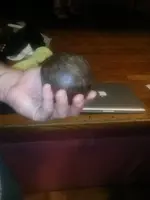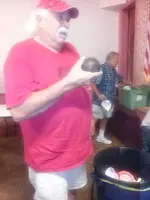Retrieved from Mohave desert just outside Barstow Ca. Many years ago. Always thought it was cannonball. The indentation had me wondering. Layers of rust off, not exactly round. Finally got measurments. Max diameter 3 1/16. Weight 54.78 oz. Indentation has a sandy feel. Help. Found laying on ground.
You are using an out of date browser. It may not display this or other websites correctly.
You should upgrade or use an alternative browser.
You should upgrade or use an alternative browser.
Cannonball Mohave
- Thread starter gregor
- Start date
diverrick
Sr. Member
- Joined
- Jan 18, 2011
- Messages
- 276
- Reaction score
- 287
- Golden Thread
- 0
- Location
- Vacaville, CA
- Detector(s) used
- Whites MXT, Minelab Eureka gold
- Primary Interest:
- Other
Explosive cannonball That was the fuse and loading hole make sure you get it inerted. I read a few years back where some guy who collected them, found one. He did not know it was a marine grade cannonball, in as such it was sealed up against moisture getting in. It blew up in his hands and killed him instantly while he was drilling it out. Not a good way to go.
Upvote
0
Bigcypresshunter
Sapphire Member
- Joined
- Dec 15, 2004
- Messages
- 27,000
- Reaction score
- 3,340
- Golden Thread
- 0
- Location
- South Florida
- Detector(s) used
- 70's Whites TM Amphibian, HH Pulse, Ace 250
- Primary Interest:
- Beach & Shallow Water Hunting
CannonBallGuy can help
Upvote
0
Honest Samuel
Banned
- Joined
- Sep 23, 2015
- Messages
- 8,808
- Reaction score
- 4,971
- Golden Thread
- 0
- Location
- Connecticut
- Detector(s) used
- Minelab
- Primary Interest:
- All Treasure Hunting
When finding cannonballs, do not touch, call the police. You live longer.
Upvote
0
MidMoTreasure
Sr. Member
- Joined
- Jul 2, 2012
- Messages
- 335
- Reaction score
- 713
- Golden Thread
- 0
- Location
- Mid-Missouri
- Detector(s) used
- Minelab CTX 3030, Minelab E-Trac, Garrett Super Sluice, Banjo Pan
- Primary Interest:
- All Treasure Hunting
Check the hole area. Does it have threads tapped into it? I suspect what you have is a decorative iron ball, possibly a gate post. The weight and diameter you provided does not match up with any known figures from the shot table. Tables for Artillery Projectiles
Upvote
0
- #6
Thread Owner
Check the hole area. Does it have threads tapped into it? I suspect what you have is a decorative iron ball, possibly a gate post. The weight and diameter you provided does not match up with any known figures from the shot table. Tables for Artillery Projectiles
I Dont see any threads.
Upvote
0
nhbenz
Gold Member
- Joined
- Dec 30, 2004
- Messages
- 6,821
- Reaction score
- 6,848
- Golden Thread
- 0
- Location
- Brentwood, NH
- Detector(s) used
- White's Classic SL
White's Surf P.I.
Yes, and probably correct the misconceptions of the dangers of cannonballs (again).CannonBallGuy can help
Upvote
0
TheCannonballGuy
Gold Member
- Joined
- Feb 24, 2006
- Messages
- 6,606
- Reaction score
- 13,450
- Golden Thread
- 0
- Location
- Occupied CSA (Richmond VA)
- Detector(s) used
- White's 6000, Nautilus DMC-1, Minelab
- Primary Interest:
- Relic Hunting
Yes, I'm going to have to contradict the scare-mongering misinformation. I am speaking as the co-author of the 552-page reference book "Field Artillery Projectiles Of The American Civil War," and as a US-Government-recognized expert at deactivating civil war era (and earlier) artillery projectiles, for over 40 years. The US National Park Service has used me to "make safe" several civil war shells found by Park Rangers on Battlefield Park properties.
In actual, well-proven fact, cannonballs (even explosive ones) are NOT dangerous to handle, or drop. The proof: we relic-diggers have dug up about 100,000 civil war (and earlier) artillery projectiles, without even a single one exploding during the digging-up process. We commonly, unavoidably hit the civil war artillery shell with a shovel when digging it up, because you don't know you've gotten down to it until you hear the shovel go "clang." I repeat, for emphasis, not even one explosion resulting from those 100,000 digs. Which proves that unlike more-modern artillery shells, excavated civil war (and earlier) ones are not "shock sensitive."
On ALL of the few occasions when a civil war artillery shell has exploded in modern times, somebody was either using a power-tool on it, or they put it in a hot fire or oven. If you can avoid doing such provocative things, the only way a pre-1870s artillery shell can hurt you is if you drop it on your foot.
I'm sure some people will want to argue about that, but I say, they will be arguing with the 100,000 no-explosion excavations of civil war (and earlier) artillery projectiles.
Somebody in this discussion-thread said "When finding cannonballs, do not touch, call the police. You live longer."
I'm sure that was meant as well-intended advice... but it is incorrect. The reason the police broadcast the message that ALL artillery shells are too deadly for a civilian to even touch is, most civilians and even most policemen cannot visually tell the difference between a relatively harmless civil war shell and a genuinely deadly World War One (or later) shell. So, the rule is to treat them ALL as if every one of them is full of Nitroglycerin. Okay, I can understand that, at least for the "bullet-shaped" artillery shells. But because there's no such thing as a cannonball filled with 20th-Century high explosives, all cannonBALLS are harmless to simply handle, or even, to drop on the sidewalk.
For Gregor, the finder of the Mohave Desert ball:
When a cannonball is loaded into the cannon barrel (and when it gets fired), it "rolls over" as it travels along the inside the (pipe-like) cannon barrel. Therefore, it MUST be carefully manufactured to be perfectly-round, because if it is even slightly out-of-round (like, egg-shaped), it will jam inside the barrel. That is very bad news for the cannon crew, especially it if happens upon firing the cannon, because jamming can cause the cannon barrel to explosively burst. The Mohave Desert "ball" is clearly out-of-round, as Gregor himself mentioned... so it absolutely cannot be a cannonball.
I co-wrote a detailed educational article on how to determine with 100% CERTAINTY whether a metal ball is an actual cannonball, or not. You can read it for free, online, at:
SolidShotEssentialsMod
In actual, well-proven fact, cannonballs (even explosive ones) are NOT dangerous to handle, or drop. The proof: we relic-diggers have dug up about 100,000 civil war (and earlier) artillery projectiles, without even a single one exploding during the digging-up process. We commonly, unavoidably hit the civil war artillery shell with a shovel when digging it up, because you don't know you've gotten down to it until you hear the shovel go "clang." I repeat, for emphasis, not even one explosion resulting from those 100,000 digs. Which proves that unlike more-modern artillery shells, excavated civil war (and earlier) ones are not "shock sensitive."
On ALL of the few occasions when a civil war artillery shell has exploded in modern times, somebody was either using a power-tool on it, or they put it in a hot fire or oven. If you can avoid doing such provocative things, the only way a pre-1870s artillery shell can hurt you is if you drop it on your foot.
I'm sure some people will want to argue about that, but I say, they will be arguing with the 100,000 no-explosion excavations of civil war (and earlier) artillery projectiles.
Somebody in this discussion-thread said "When finding cannonballs, do not touch, call the police. You live longer."
I'm sure that was meant as well-intended advice... but it is incorrect. The reason the police broadcast the message that ALL artillery shells are too deadly for a civilian to even touch is, most civilians and even most policemen cannot visually tell the difference between a relatively harmless civil war shell and a genuinely deadly World War One (or later) shell. So, the rule is to treat them ALL as if every one of them is full of Nitroglycerin. Okay, I can understand that, at least for the "bullet-shaped" artillery shells. But because there's no such thing as a cannonball filled with 20th-Century high explosives, all cannonBALLS are harmless to simply handle, or even, to drop on the sidewalk.
For Gregor, the finder of the Mohave Desert ball:
When a cannonball is loaded into the cannon barrel (and when it gets fired), it "rolls over" as it travels along the inside the (pipe-like) cannon barrel. Therefore, it MUST be carefully manufactured to be perfectly-round, because if it is even slightly out-of-round (like, egg-shaped), it will jam inside the barrel. That is very bad news for the cannon crew, especially it if happens upon firing the cannon, because jamming can cause the cannon barrel to explosively burst. The Mohave Desert "ball" is clearly out-of-round, as Gregor himself mentioned... so it absolutely cannot be a cannonball.
I co-wrote a detailed educational article on how to determine with 100% CERTAINTY whether a metal ball is an actual cannonball, or not. You can read it for free, online, at:
SolidShotEssentialsMod
Last edited:
Upvote
0
H-2 CHARLIE
Bronze Member
- Joined
- Dec 1, 2012
- Messages
- 1,204
- Reaction score
- 507
- Golden Thread
- 0
- Location
- on the rocks - so cal county line
- Detector(s) used
- Gold bug pro / Minelab GM 1000
- Primary Interest:
- All Treasure Hunting
Upvote
0
H-2 CHARLIE
Bronze Member
- Joined
- Dec 1, 2012
- Messages
- 1,204
- Reaction score
- 507
- Golden Thread
- 0
- Location
- on the rocks - so cal county line
- Detector(s) used
- Gold bug pro / Minelab GM 1000
- Primary Interest:
- All Treasure Hunting
Upvote
0
TheCannonballGuy
Gold Member
- Joined
- Feb 24, 2006
- Messages
- 6,606
- Reaction score
- 13,450
- Golden Thread
- 0
- Location
- Occupied CSA (Richmond VA)
- Detector(s) used
- White's 6000, Nautilus DMC-1, Minelab
- Primary Interest:
- Relic Hunting
I forgot to mention... if any of you TreasureNet readers find a bullet-shaped artillery projectile, post it here in the What Is It? forum, so we can tell you what time-period it is from, and whether you need to call the Bomb Squad, or not. (No need for the Bomb Squad if it is from the civil war era... and there are Professional people who can make civil war ones inert for you.)
Upvote
0
NOLA_Ken
Gold Member
- Joined
- Jan 4, 2011
- Messages
- 5,214
- Reaction score
- 4,179
- Golden Thread
- 0
- Location
- Formerly New Orleans.. Now Pueblo Co
- Detector(s) used
- several, mostly Garrett
- Primary Interest:
- All Treasure Hunting
Aquachigger has a very good video on youtube where he tries to light Civil War black powder from recovered cannonballs and unsurprisingly it's not very volatile. He also offers a few theories on why cannonballs explode when improperly drilled or tossed in fires. Definitely worth a watch.
This ball with a hole in it I would guess is a gate weight or some other kind of counterweight since there was no need for those to be perfectly round. Hard to say for sure though
This ball with a hole in it I would guess is a gate weight or some other kind of counterweight since there was no need for those to be perfectly round. Hard to say for sure though
Upvote
0
mthanded
Greenie
- Joined
- Dec 9, 2007
- Messages
- 14
- Reaction score
- 11
- Golden Thread
- 0
- Location
- uniontown, pennsylvania
- Detector(s) used
- ATPRO
I found something like that in the woods by a high school... though it was a cannonball... I was wrong it was a shot put ball for track and field
Sent from my iPhone using Tapatalk
Sent from my iPhone using Tapatalk
Upvote
0
Similar threads
- Replies
- 5
- Views
- 786
- Replies
- 18
- Views
- 2K
Users who are viewing this thread
Total: 1 (members: 0, guests: 1)






